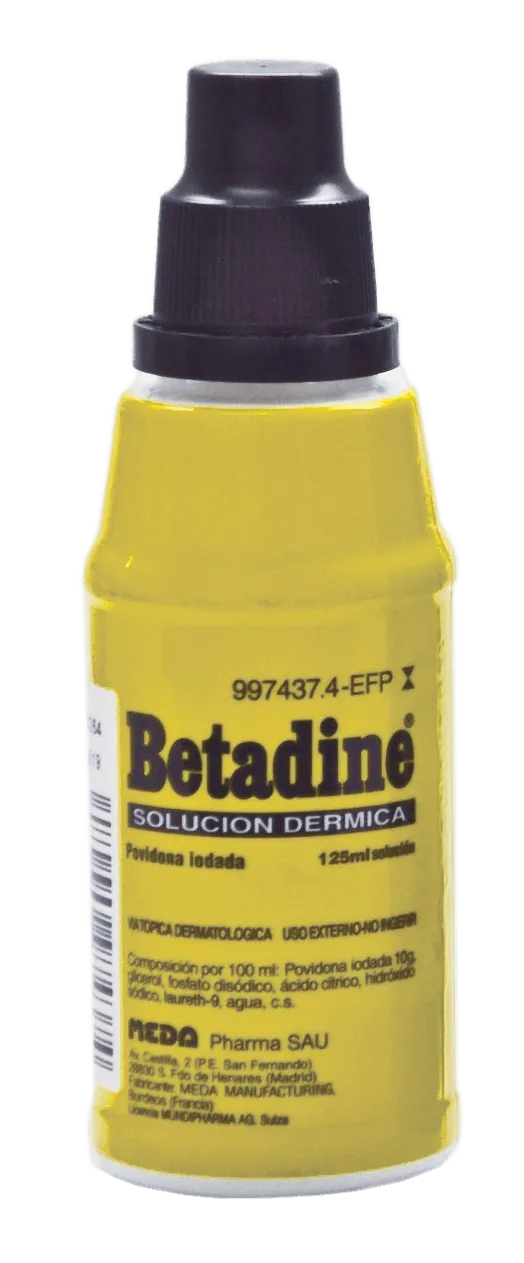Chapitre 5
Activité 3 - Activité expérimentale
60 min
Titrage colorimétrique
Ressource affichée de l'autre côté.
Faites défiler pour voir la suite.
Faites défiler pour voir la suite.
Problématique de l'activit�é
On cherche à effectuer un titrage colorimétrique de la bétadine afin de vérifier la concentration en diiode de cet antiseptique.
Quel réactif titrant faut-il choisir ?


Ressource affichée de l'autre côté.
Faites défiler pour voir la suite.
Faites défiler pour voir la suite.
Ressource affichée de l'autre côté.
Faites défiler pour voir la suite.
Faites défiler pour voir la suite.
Doc. 1 La bétadine


- Pathologies : Antisepsie des plaies et brûlures superficielles et peu étendues.
- L'étiquette de la bétadine précise : Bétadine 10 %.
- Principes actifs : Diiode (\text{I}_{2}) : 1,08 g pour 100 mL.
- Excipients : Glycérol (E422), Macrogol laurique ether, Phosphate disodique, Acide citrique (E330), Eau purifiée.
- Incompatibilités : Le diiode est un oxydant.
Chaleur, lumière, inactivé par le thiosulfate de sodium.
Ressource affichée de l'autre côté.
Faites défiler pour voir la suite.
Faites défiler pour voir la suite.
Doc. 2 Schéma de l'expérience

Ressource affichée de l'autre côté.
Faites défiler pour voir la suite.
Faites défiler pour voir la suite.
Doc. 3 Quelques couples redox
Ressource affichée de l'autre côté.
Faites défiler pour voir la suite.
Faites défiler pour voir la suite.
Bétadine (diiode) : \text{I}_{2}(\text{aq}) ;
Sulfate de cuivre (II) : (\mathrm{Cu}^{2+}(\mathrm{aq}) \,; \,\mathrm{SO}_{4}^{2-}(\mathrm{aq})) ;
Sulfate de fer (III) : (2\mathrm{Fe}^{3+}(\mathrm{aq}) \,;\, 3\mathrm{SO}_{4}^{2-}(\mathrm{aq})) ;
Thiosulfate de sodium : (2\, \mathrm{Na}^{+}(\mathrm{aq})\, ; \,\mathrm{S}_{2} \mathrm{O}_{3}^{2-}(\mathrm{aq})) ;
Permanganate de potassium : (\mathrm{K}^{+}(\mathrm{aq}) \,; \,\mathrm{MnO}_{4}^{-}(\mathrm{aq})) ;
c=5\text{,}0 \times 10^{-3} mol·L-1 ;
Ressource affichée de l'autre côté.
Faites défiler pour voir la suite.
Faites défiler pour voir la suite.
Découvrez un sur les principes de fonctionnement et de précaution de différents antiseptiques.
Ressource affichée de l'autre côté.
Faites défiler pour voir la suite.
Faites défiler pour voir la suite.
Ressource affichée de l'autre côté.
Faites défiler pour voir la suite.
Faites défiler pour voir la suite.
Questions
Compétence(s)
RAI/ANA : Justifier un protocole
RÉA : Mettre en œuvre un protocole
RÉA : Mettre en œuvre un protocole
1. Relever les informations utiles pour effectuer le titrage.
2. Quelles espèces chimiques ne conviennent pas au titrage du diiode ? Justifier.
3. Établir l'équation de la réaction de titrage.
4. Réaliser une dilution au 10e de la bétadine puis réaliser le titrage avec l'espèce chimique proposée et l'indicateur coloré de fin de réaction. Le volume équivalent correspond-il à celui indiqué dans les données ?
5. Décrire l'évolution observée de la transformation chimique.
4. Réaliser une dilution au 10e de la bétadine puis réaliser le titrage avec l'espèce chimique proposée et l'indicateur coloré de fin de réaction. Le volume équivalent correspond-il à celui indiqué dans les données ?
5. Décrire l'évolution observée de la transformation chimique.
Ressource affichée de l'autre côté.
Faites défiler pour voir la suite.
Faites défiler pour voir la suite.
Synthèse de l'activité
Quels sont les critères à prendre en compte pour effectuer un titrage colorimétrique
s'appuyant sur une réaction d'oxydoréduction ?
Une erreur sur la page ? Une idée à proposer ?
Nos manuels sont collaboratifs, n'hésitez pas à nous en faire part.
j'ai une idée !
Oups, une coquille


